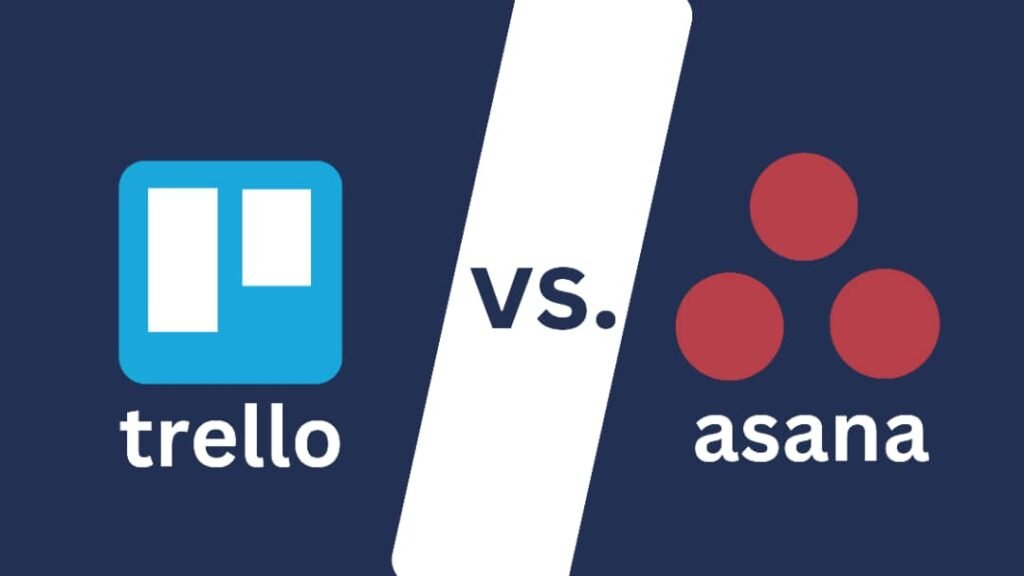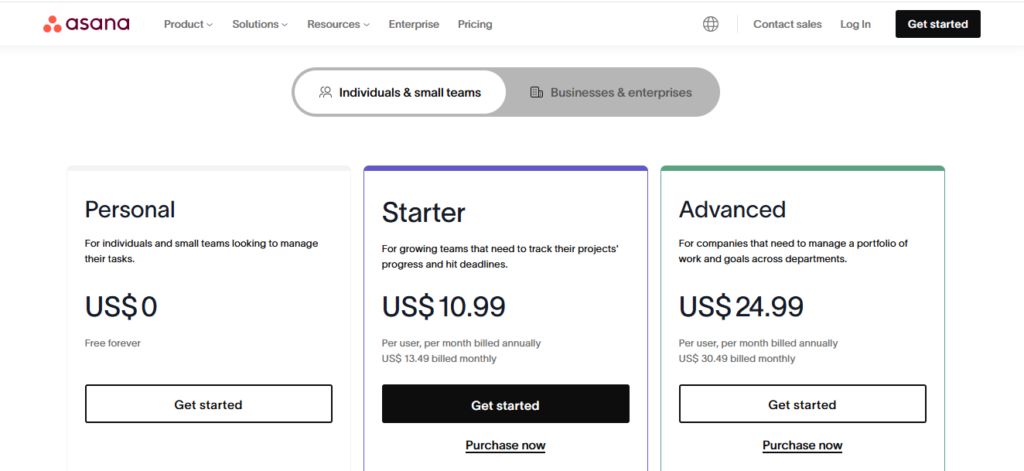By Abiola Gbolahan
Edited By Fredrick Oladipupo

Table of Contents
1. Introduction: Asana vs Trello
In a world where remote and hybrid work models have become the new norm, the best project management tool for teams is no longer a luxury—it’s a necessity. Particularly, for teams spread across various locations or balancing in-office and remote schedules. The right project management tool is the backbone of productivity, communication, and seamless collaboration. Without one, projects risk falling apart as communication gaps and missed deadlines pile up.
As we step into 2025, tools like Asana and Trello have evolved dramatically to meet the demands of modern teams. They have risen as the popular choices. Not only for their unique features but also for their adaptability to different work styles and team needs. With improved task management, communication, and workflow visualization. These tools are at the forefront of helping businesses organize and optimize their work.
Our aim today is to deep dive into the capabilities of Asana and Trello. Compare their features, ease of use, pricing, and which types of teams stand to gain the most from each platform. Whether you’re managing a small, or a large cross-functional team, we will help you determine which tool is best fit for you in 2025.
2. Overview of Asana vs Trello
2.1 Brief Introduction to Asana

Asana, launched in 2008 by Facebook co-founder Dustin Moskovitz and engineer Justin Rosenstein, was initially designed to improve productivity and team collaboration within Facebook. Recognizing broader potential, they developed it into a standalone project management tool in 2012, specifically tailored for organizations needing structured task management, clear communication, and efficient project tracking.
Asana’s design focuses on reducing email reliance by allowing users to communicate directly within tasks, set deadlines, and monitor progress across projects. Its distinctive features, such as task assignments, due dates, project status updates, and a dedicated “My Tasks” view for personal planning, help users organize their work and prioritize effectively.
Since its inception, Asana has grown to include advanced features. Gantt-style timelines, project dashboards, and workload management, aiming to support diverse team needs across industries.
2.2 Brief Introduction to Trello

Trello is a popular project management tool that helps teams organize tasks and workflows visually. Its unique card-based system simplifies task management by allowing users to create boards (which represent projects), lists (representing task stages), and cards (which represent individual tasks). This approach makes it especially easy to track progress and maintain clarity across projects. Whether you’re managing a personal task list or collaborating with a large team; Trello’s visual format provides a straightforward way to stay organized.
Since its launch in 2011 by Fog Creek Software(now Glitch). Trello has been favored for its simplicity, adaptability, and ease of use, particularly among businesses that need a scalable, efficient way to manage projects. Its core features include customizable workflows, team collaboration tools, and integration with popular apps like Google Drive and Slack. Trello offers automation capabilities through its “Butler” feature. This can handle repetitive tasks such as moving cards between lists based on set triggers.
Overall, Trello’s visual approach to project management, coupled with its flexibility, makes it an ideal tool for teams looking to streamline task management and improve communication.
2.3 Primary Use Cases: Asana vs. Trello
Asana is ideal for teams managing complex projects with multiple dependencies, deadlines, and workflows. It’s robust for handling detailed task management, project tracking, and cross-team collaboration. This makes it a go-to for larger teams or organizations with needs for advanced project features like timelines, workload management, and reporting.
Trello, on the other hand, excels at visually organized workflows. Its card-based system makes it particularly effective for smaller teams or personal projects where simplicity, flexibility, and a clear, visual overview are essential. So, It’s a great tool for teams that prioritize ease of use and intuitive task management over complex project dependencies.
3. Features Comparison: Asana vs Trello
| Features | Asana | Trello |
|---|---|---|
| Task and Project Management | Task Dependencies & Milestones: Asana supports complex projects with task dependencies, milestones, and timeline views, helping teams manage deadlines and dependencies effectively. | Board, Card & List Layout: Trello uses a simple, visual structure with boards for projects, lists for stages, and cards for tasks, making it ideal for straightforward project tracking. |
| Team Collaboration | Collaborative Tools: Asana allows teams to comment on tasks, engage in project conversations, and assign tasks to multiple team members, improving collaboration on large projects. | Card-Based Comments & Attachments: Trello’s comments, attachments, and tagging system within cards simplify tracking team contributions and feedback. |
| Customization & Integrations | Customizable Workflows & Integrations: Asana integrates with tools like Slack, Google Drive, and time-tracking apps. It also allows teams to customize workflows to fit specific needs. | Power-Ups & Automation: Trello’s Power-Ups (integrations) allow for enhanced functionality, while the Butler automation tool streamlines repetitive tasks and improves workflow efficiency. |
| Mobile & Cross-Platform Availability | Mobile Apps & Desktop Compatibility: Asana offers strong mobile and desktop applications, ensuring seamless access across devices for teams. | Mobile Apps & Cross-Platform Syncing: Trello also provides mobile apps and desktop access, syncing tasks across platforms for easy collaboration, especially for remote teams |
4. Ease of Use: Asana vs Trello
4.1 Learning Curve
Trello’s straightforward, card-based layout makes it an ideal choice for beginners. Its simple, visual structure allows users to easily create boards, lists, and cards to manage tasks with minimal effort. In addition, The drag-and-drop functionality, combined with a clean, uncluttered interface, makes it very easy to pick up and start using immediately. It’s simplicity makes it a popular choice for smaller teams and individuals to organize tasks without extensive training.
Conversly, Asana can have a steeper learning curve due to its more advanced features, task dependencies, milestones, and project timelines. While these features are powerful for managing complex projects, they require more time to master. Teams new to project management might find the range of options initially overwhelming. However, once learned, they provide a deeper level of control and flexibility.
4.2 User Interface
Asana’s user interface follows a structured, list-based format, where tasks and subtasks are clearly organized in rows. This layout is ideal for teams that need to track progress in a detailed, linear manner. Asana’s design emphasizes structure and clarity, with various views such as List, Board, Timeline, and Calendar, providing different ways to interact with tasks and projects.
In contrast, Trello’s user interface is more visual, centered around a board system. Each project is represented by a board. They contain lists that visually represent stages of a project, and cards for tasks. This card-based system allows for a quick, intuitive understanding of task status, and the visual nature of the interface is excellent for teams that prefer a more tactile, flexible workflow.
4.3 Customization Options
Asana offers customization options primarily through adjusting views and workflows. Users can create custom fields to track specific project attributes. Adjust task views to fit different workflows, and automate processes with rules. Asana’s flexibility in configuring project layouts and processes is excellent for teams with specific, nuanced needs.
Trello also provides customization, but it does so through its Power-Ups (integrations) and the ability to create unique board structures. Users can add extra features by integrating tools like Slack, Google Drive, and time-tracking apps. Additionally, Trello’s Butler feature allows automation of repetitive tasks.It provides a layer of customization for recurring actions.
5. Pricing and Plans: Asana vs Trello

| Plan | Asana Pricing | Trello Pricing |
|---|---|---|
| Free Plan | Free for up to 15 users. Basic task and project management features. | Free, includes unlimited boards, lists, and cards, but limits Power-Ups to 1 per board |
| Premium Plan | $10.99 per user/month. Adds timeline view, custom fields, advanced search, and reporting. | $5 per user/month. Removes Power-Up restrictions and adds larger file attachments. |
| Business Plan | $24.99 per user/month. Includes portfolios, workload management, and advanced integrations | $10 per user/month. Includes dashboards, timelines, and priority support. |
| Enterprise Plan | Custom pricing. Advanced security, compliance features, and dedicated support. | $17.50 per user/month (starting price). Advanced admin controls, security features, and support. |

5.1 Value for Money
Small Teams: For small teams or personal use, Trello’s free plan offers significant value with its simple interface and core features. Asana’s free plan is also good but may be limited when handling more complex projects. Trello’s simplicity and ease of use make it an affordable choice for teams with basic needs.
Large Organizations: Asana’s Business and Enterprise plans may offer better value for larger organizations due to its more robust project tracking, reporting, and team management capabilities. Its price is slightly higher but justifiable for teams managing more intricate workflows. Trello’s Enterprise plan can also scale well for larger teams, but it may require additional Power-Ups and integrations, which could increase.
In summary, Asana is better suited for teams that need detailed project management features. Whereas, Trello offer better value for teams looking for a more visual, straightforward tool at a lower cost.
6. Best Fit by Team Type: Asana vs Trello

6.1 For Small Teams and Startups
For small teams and startups, Trello is typically the easier tool to get started with and scale as the team grows. Its visual, simple board-and-card layout requires minimal onboarding and is intuitive enough for teams with limited project management experience. The free plan offers plenty of features for small teams, and the flexible, straightforward design allows users to adapt the tool as their needs evolve.
As teams expand, Trello’s Power-Ups (integrations) and Butler automation can help add complexity and scale without overwhelming the team. However, if a startup expects rapid growth and requires more detailed project tracking, Asana‘s features like task dependencies, timelines, and reporting could become essential as the team grows larger.
6.2 For Remote and Distributed Teams
Remote and distributed teams benefit from collaboration features that facilitate communication across time zones. Asana offers powerful collaboration tools such as task assignments, project conversations, and file sharing. These are great for teams working asynchronously. Its ability to manage tasks with detailed information like deadlines, dependencies, and milestones is crucial for teams spread across different time zones.
Trello also supports collaboration with its card-based comments, mentions, and attachments, making it a solid choice for teams that need to keep things visually organized. While Trello’s simplicity might not provide as much depth for detailed project tracking. It also offers real-time collaboration tools, which makes it a good option for smaller remote teams or teams that favor visual task management.
6.3 For Large Organizations with Complex Needs
For large organizations managing complex projects with multiple cross-functional teams. Asana stands out due to its ability to handle intricate workflows. Features like portfolios, workload management, and advanced reporting allow large teams to manage dependencies, monitor progress across various departments, and ensure that projects stay on track. Likewise, Asana’s more advanced project management capabilities make it ideal for organizations with complex needs and larger teams that need extensive reporting and collaboration features.
Trello, while powerful in its own right, may struggle with managing large projects that require detailed tracking of dependencies, timelines, and cross-team collaboration. Its visual, board-based design is more suited for less complex workflows. However, for teams with fewer dependencies or smaller cross-functional projects, Trello can still serve as an excellent tool.
7. Pros and Cons Summary: Asana vs Trello
7.1 Asana Pros and Cons
7.2 Trello Pros and Cons
| Pros | Cons |
|---|---|
| Easy Setup: Simple interface that is intuitive and quick to get started with minimal learning required | Less Suitable for Complex Projects: Trello may struggle with larger projects due to its lack of advanced features without add-ons |
| Visual Layout: The card-based system is highly visual, making it easy to track and organize tasks | Limited Features in Free Version: Free plan has restrictions, such as a limit on Power-Ups, which may hinder growth |
| Free Plan Availability: Offers a free plan with core features such as unlimited boards, lists, and cards, ideal for small teams | Requires Add-Ons for Advanced Functionality: Teams may need third-party integrations to access features like dependencies and advanced reporting |
| Highly Customizable Boards: Through Power-Ups and Butler automation, Trello allows deep customization to meet team needs |
8. Conclusion: Asana vs Trello
Choosing the right project management tool is important for team productivity, especially in today’s era of remote and hybrid work. Asana and Trello each offer unique strengths that cater to different team needs. Specifically, Asana excels in managing complex, large-scale projects with advanced features like task dependencies, milestones, and multiple view options, making it well-suited for larger teams or organizations with intricate workflows. Trello, on the other hand, is known for its straightforward, card-based layout that allows for easy visualization of tasks, making it a great choice for smaller teams or projects that prioritize simplicity and ease of use.
Additionally, When deciding between the two, consider factors like your team’s size, budget, and the complexity of your projects. If your team handles multi-step projects with a need for detailed tracking and dependencies, Asana’s robust capabilities might be worth the investment. However, if you’re looking for a tool that is quick to set up and visually appealing, Trello’s flexible board system and simple setup could be the perfect fit for you.
You might also be interested in reading my comparison between the leading payment Gateways: Stripe vs Paypal and in Nigeria Paystack vs Flutterwave.
Additionally, for those managing marketing needs, my comparison of Mailchimp vs. ConvertKit: Which Email Marketing Tool Fits Your Needs provides insights into selecting the right email marketing platform.


